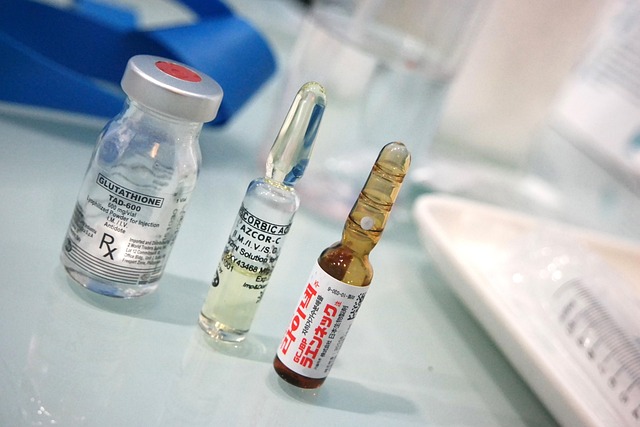The semaglutide injectable form, effective for weight loss and diabetes management, requires careful handling and storage. It should be stored in a cool, dry place (2°C to 8°C) away from light and humidity, avoiding freezing. Proper techniques include aseptic environment maintenance, accurate dose measurement, and using recommended syringe/needle combinations. Home storage necessitates similar conditions, tracking expiry dates, and responsible disposal methods to prevent environmental contamination and personal harm.
“Discover the optimal way to store and handle semaglutide injections with our comprehensive guide. From understanding the unique properties of this injectable form to mastering safety protocols, this article covers all aspects of proper management. Learn about ideal storage conditions, precise handling techniques, and effective strategies to tackle common challenges. Additionally, explore inventory tracking tips and eco-conscious disposal practices. Gain valuable insights into the optimal care of semaglutide injectable form, ensuring its effectiveness and safety throughout use.”
Understanding Semaglutide Injectable Form: A Comprehensive Overview

Semaglutide, a medication widely known for its role in diabetes management, is increasingly recognized for its benefits in weight loss. Its injectable form, semaglutide injectable, offers a convenient and effective way to achieve therapeutic goals. This form typically comes in pre-filled pens or vials, allowing for precise dosing and administration. Understanding the unique properties of this medication is crucial for optimal storage and handling practices.
The semaglutide injectable form is designed for subcutaneous injection, usually once weekly. It’s essential to store it properly, keeping it refrigerated at all times to maintain its potency and stability. Additionally, patients should be educated on how to handle the medication safely, including proper disposal methods to prevent misuse or accidental ingestion. By adhering to these guidelines, healthcare providers can ensure that patients receive the maximum benefits of semaglutide while minimizing potential risks.
Proper Storage Conditions for Optimized Effectiveness

Proper storage conditions are essential for maintaining the effectiveness and stability of semaglutide injections, a crucial aspect in ensuring optimal therapeutic outcomes. The semaglutide injectable form is sensitive to temperature fluctuations, light exposure, and humidity levels. To preserve its potency, it should be stored in a cool, dry place, typically between 2°C and 8°C (35°F to 46°F). Refrain from freezing the medication as this can lead to changes in its physical characteristics.
Additionally, protect the semaglutide vials or pens from direct sunlight and keep them out of reach from excessive moisture. It’s recommended to use a well-sealed container or refrigerator designed for storing medications to maintain optimal storage conditions, ensuring the medicine remains effective until its expiration date.
Handling Techniques to Ensure Safety and Precision

Proper handling techniques are essential for storing and administering semaglutide injections, ensuring both safety and precision. When dealing with the semaglutide injectable form, it’s crucial to maintain an aseptic environment to prevent contamination. This involves using sterile gloves, wearing a clean lab coat, and ensuring the injection site is free from any debris or foreign objects. Before each use, inspect the medication for any visible signs of degradation, such as changes in color or consistency.
To ensure accuracy, measure the required dose meticulously using the provided measurement tools. Avoid touching the needle or vial contents directly to prevent introducing impurities. Instead, use the sterile syringe and needle combination recommended for semaglutide administration. Once the injection is complete, properly dispose of the used needles and vials in designated sharps containers to maintain a safe and hygienic environment.
Common Challenges in Storing Semaglutide Injections and How to Overcome Them

Storing semaglutide injections, especially in the home setting, presents unique challenges for patients and caregivers. One of the primary difficulties is maintaining the stability and efficacy of the medication, as semaglutide is sensitive to temperature fluctuations. To overcome this, it’s crucial to store the injectable form of semaglutide in a cool, dry place, ideally between 2°C and 8°C (35°F and 46°F). Using proper storage containers designed for medications can help regulate temperature and protect against light exposure.
Additionally, ensuring proper handling is essential to prevent contamination. Users should always wash their hands before preparing or administering the injection. Clean, sterile syringes and needles are vital to avoid introducing foreign particles into the medication. Moreover, keeping a close eye on expiration dates and following manufacturer guidelines for disposal methods will minimize the risk of adverse reactions and ensure the safety of each dose.
Tips for Tracking Expiry Dates and Managing Inventory

Staying organized is key when storing and managing semaglutide injections. To ensure you always have access to fresh medication, implement a rigorous tracking system for expiry dates. Consider using a dedicated inventory management software or keeping a physical log where you note down the date of purchase, expiration, and quantity received for each batch. Regularly check your supplies and set reminders to restock before the expiry date.
For the semaglutide injectable form, it’s crucial to store them properly – typically in a cool, dry place away from direct sunlight. Keep track of usage and discard expired vials responsibly according to local regulations. This meticulous approach will help you maintain an efficient inventory, ensuring uninterrupted access to your semaglutide injections.
Best Practices for Disposal: Environmental Considerations and Safety Protocols

When disposing of semaglutide injections, it’s crucial to prioritize both environmental safety and personal protection. The semaglutide injectable form should never be discarded in regular trash or poured down the drain due to its potential risks to aquatic life and the environment. Instead, follow local regulations for proper disposal, which may involve using designated pharmaceutical waste collection programs or special hazardous waste facilities.
To minimize ecological impact, ensure all used injection sites are cleaned thoroughly with water and soap, then disposed of in a sealed container. Needles and syringes should be placed in rigid, leak-proof containers labeled as sharps waste to prevent accidental injuries and further contamination. Remember, responsible disposal practices contribute to a healthier environment and safeguard communities from potential hazards associated with pharmaceutical waste.
